Objective: To examine the effect of enhanced external counterpulsation (EECP) on depression in patients with refractory angina pectoris (Canadian Cardiovascular Society class 2-4).
Method: The study was a prospective observational investigation with a 2-month control period preceding the EECP therapy (to minimize a possible effect of the regression-toward-the-mean phenomenon). The patients were examined 2 months before and just before EECP and just after, 3 months after, and 12 months after EECP. Depression was assessed using the Major Depression Inventory and the ICD-10. During EECP, 3 sets of cuffs were fastened around the lower extremities and were inflated sequentially to a pressure of 260 mm Hg in each diastole for 60 minutes 5 days a week for 7 weeks (35 sessions). The study was conducted at a regional hospital in Denmark from May 2006 to January 2011.
Results: Fifty patients with angina pectoris and an abnormal coronary angiography, with no possibility for revascularization, were included (72% men, mean age of 63 years) between May 2006 and January 2011. The prevalence of depression before EECP was 18%, just after was 2%, 3 months after was 2%, and 12 months after was 4% (P = .013). The depressive state was more severe at a lower age (P = .016). No significant predictors of effect of EECP on depression were found (P > .05), and no association was detected between decline in depressive state and chest pain (P > .05).
Conclusions: The study indicates that EECP is an effective treatment for depression in patients with refractory angina pectoris, that depression is more severe in younger patients, and that the effect of EECP on depression is not related to the effect on chest pain.
Trial Registration: ClinicalTrials.gov identifier: NCT01112163
Enhanced External Counterpulsation Is an Effective Treatment
for Depression in Patients With Refractory Angina Pectoris
ABSTRACT
Objective: To examine the effect of enhanced external counterpulsation (EECP) on depression in patients with refractory angina pectoris (Canadian Cardiovascular Society class 2–4).
Method: The study was a prospective observational investigation with a 2-month control period preceding the EECP therapy (to minimize a possible effect of the regression-toward-the-mean phenomenon). The patients were examined 2 months before and just before EECP and just after, 3 months after, and 12 months after EECP. Depression was assessed using the Major Depression Inventory and the ICD-10. During EECP, 3 sets of cuffs were fastened around the lower extremities and were inflated sequentially to a pressure of 260 mm Hg in each diastole for 60 minutes 5 days a week for 7 weeks (35 sessions). The study was conducted at a regional hospital in Denmark from May 2006 to January 2011.
Results: Fifty patients with angina pectoris and an abnormal coronary angiography, with no possibility for revascularization, were included (72% men, mean age of 63 years) between May 2006 and January 2011. The prevalence of depression before EECP was 18%, just after was 2%, 3 months after was 2%, and 12 months after was 4% (P = .013). The depressive state was more severe at a lower age (P = .016). No significant predictors of effect of EECP on depression were found (P > .05), and no association was detected between decline in depressive state and chest pain (P > .05).
Conclusions: The study indicates that EECP is an effective treatment for depression in patients with refractory angina pectoris, that depression is more severe in younger patients, and that the effect of EECP on depression is not related to the effect on chest pain.
Trial Registration: ClinicalTrials.gov identifier: NCT01112163
Prim Care Companion CNS Disord 2015;17(4):doi:10.4088/PCC.14m01748
© Copyright 2015 Physicians Postgraduate Press, Inc.
Submitted: November 18, 2014; accepted March 30, 2015.
Published online: August 20, 2015.
Corresponding author: Ole May, MD, PhD, FESC, Department of Medicine, Region Hospital Herning, Gl. Landevej 61, Denmark 7400 Herning
([email protected]).
Depression is a frequent finding in patients with ischemic heart disease, and the presence of depression in such patients is known to predict a poor prognosis.1–17 The causative link between depression and the impaired prognoses in patients with ischemic heart disease is not yet known.
Enhanced external counterpulsation (EECP) is a noninvasive therapy for angina pectoris offered to patients with coronary artery disease who are not candidates for revascularization. In a study by Lawson and colleagues,18 EECP was shown to reduce chest pain in 70%–80% of patients with refractory angina pectoris at least 1 Canadian Cardiovascular Society (CCS) class. During EECP therapy, 3 sets of cuffs are fastened around the lower extremities, and in diastole, the cuffs are inflated to a pressure of 260–300 mm Hg, generating a backward diastolic flow of blood that increases the flow in the coronary arteries to 2.5 times the baseline flow.19 The treatment is usually given for 1 hour 5 days a week for 7 weeks.
The effect of EECP on depression has been assessed in a small uncontrolled study with 28 patients with refractory angina pectoris.20 The study used the Beck Depression Inventory and the Symptom Checklist-90-Revised and reported a fall in the depression scales.20
The purpose of the present study was to further examine the effect of EECP on depression in patients with angina pectoris. We intended to (1) report the effect of EECP on depression, (2) locate predictors of depression in patients with refractory angina pectoris, (3) identify possible factors predictive of the effect of EECP on depression, and (4) assess if the effect of EECP on depression was associated with the effect of EECP on chest pain.
METHOD
Design
The study was a prospective observational investigation with a 2-month control period preceding the EECP therapy. The control period was introduced to minimize a possible effect of the regression-toward-the-mean phenomenon. The conduct of a randomized controlled trial was judged impossible due to anticipation of a small number of study candidates. We decided to report the results when 50 persons were included in the study. The study was conducted at a regional hospital in Denmark.
The inclusion criteria were angina pectoris CCS class 2–4, reversible ischemia on single-photon emission computed tomography, a coronary angiography giving no option for revascularization, sinus rhythm, and age > 18 years. Patients were excluded if they had cancer, dementia or an expected low compliance judged by the investigator, blood pressure ≥ 180/110 mm Hg, arrhythmias, severe valve disease, pregnancy, known aortic aneurism ≥ 55 mm, a bleeding tendency, ejection fraction < 0.25, a bradycardia pacemaker, acute coronary syndrome, revascularization within 3 months, deep vein thrombosis, or severe claudication. The patients could participate only once.
The participants were examined 5 times: 2 months before and just before EECP and just after, 3 months after, and 12 months after EECP. The patients were encouraged not to change their medication for angina pectoris during the study period.
EECP
Three sets of pneumatic cuffs were mounted on the lower extremities: 1 set around the calves, 1 set around the thighs, and 1 set around the buttocks. The cuffs were inflated sequentially to a pressure of 260 mm Hg in each diastole. The timing of the inflation was individually adjusted according to the electrocardiogram to give the highest diastolic/systolic blood pressure ratio during treatment. EECP was given for 60 minutes 5 days a week for 7 weeks (35 sessions) using EECP equipment from Vasomedical (Westbury, New York).
Depression
The presence and grade of depression were measured by the Major Depression Inventory (MDI).21 In this questionnaire, patients are asked about the symptoms required for the diagnoses according to the ICD-10.22 The questionnaire has been tested against diagnoses established by experienced psychiatrists interviewing the patients and was found to have a sensitivity as well as a specificity of 86%.21 Another approach when interpreting the result of the MDI is to sum the 10 answers, creating a rating scale ranging from 0 to 50 points, with a higher number indicating a more depressed individual. The MDI was thus used to diagnose the patients with regard to depression and to grade the degree of depressive state using the rating scale. The patients filled in the questionnaire 2 months before and just before EECP and just after, 3 months after, and 12 months after EECP.
Chest Pain
At each of the 5 control visits, the degree of chest pain was classified according to the CCS by the same investigator. During the EECP course, the patients were questioned before each treatment about the use of nitroglycerin during the last 24 hours, and the same question was asked at each later control visit.
Ethics
The study complied with the Helsinki II declaration and was approved by the local ethics committee and the Danish Data Protection Agency. Patients were only included after written informed consent was obtained (ClinicalTrials.gov identifier: NCT01112163).
Statistics
Comparisons of continuously distributed variables at the 5 timepoints were conducted by repeated-measures analysis. To account for empty cells, the type IV sum of squares was used. Differences were considered significant if the P value was < .05. The analyses were carried out using IBM SPSS Statistics 20 (Armonk, New York). Model assumptions for the repeated-measures analyses were tested by the Mauchly test of sphericity, and if the test indicated that sphericity could not be assumed, the P value calculated according to Greenhouse-Geisser was used. The change in CCS class was tested by the Friedman test for related samples. If significant within-subject changes were found during the 5 examinations, we tested change during the period before (control period) and the period after (follow-up period) EECP. The effect of EECP was calculated as the change from just before EECP to just after EECP, as well as 3 and 12 months after EECP. Paired parametric or nonparametric tests were used as appropriate.
RESULTS
From May 2006 to January 2011, we included 50 patients with refractory angina pectoris in the study. Table 1 provides baseline characteristics. All patients completed 35 EECP sessions. Three months after EECP, 1 patient had died and 1 declined to be examined. Twelve months after EECP, an additional 6 persons declined to be examined, but of those, 4 responded to the questionnaire. No significant change was detected in the medications taken by the patients to treat angina pectoris (P > .40) or depression (P = .41) during the study period. At the examination 2 months before EECP, 10 patients took antidepressants; 1 stopped just after EECP, and the remaining 9 continued throughout the study.
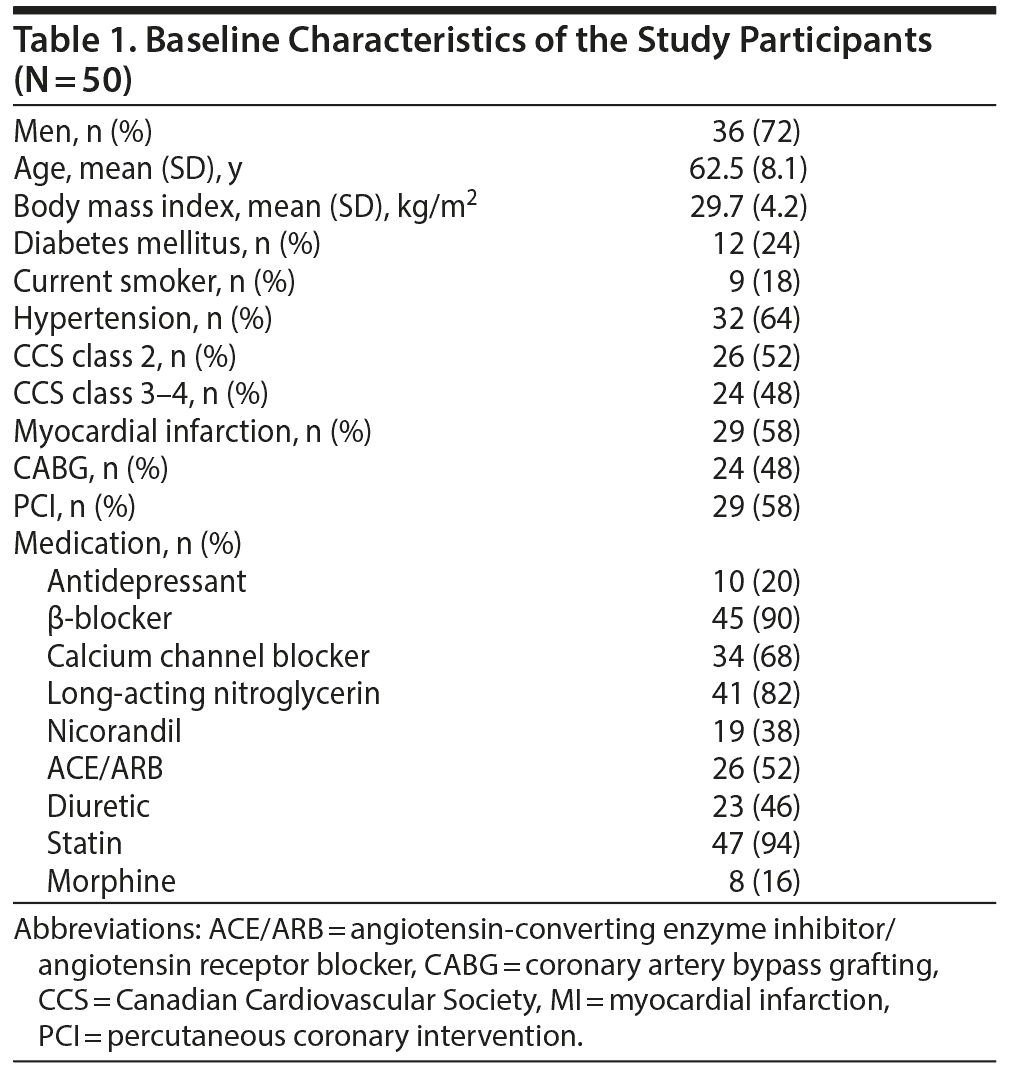
Chest Pain
The mean daily number of angina pectoris attacks reported by the patients was significantly reduced during the 7-week EECP course from 2.7 to 0.9 (P < .005). No significant change was found in the mean daily number of angina pectoris attacks between the last week of the EECP course (0.9) and 3-month (1.0) and 12-month (1.3) follow-up, although the number of angina pectoris attacks tended to increase (P = .82).
The mean CCS class was significantly reduced after EECP compared to before EECP (Table 2). Compared to just before EECP, the CCS class was at least 1 class lower just after EECP in 82% of the patients, 3 months after in 79%, and 12 months after in 76% (all P < .0002). No significant change in CCS class was found during the control period or during the follow-up period (P > .10).
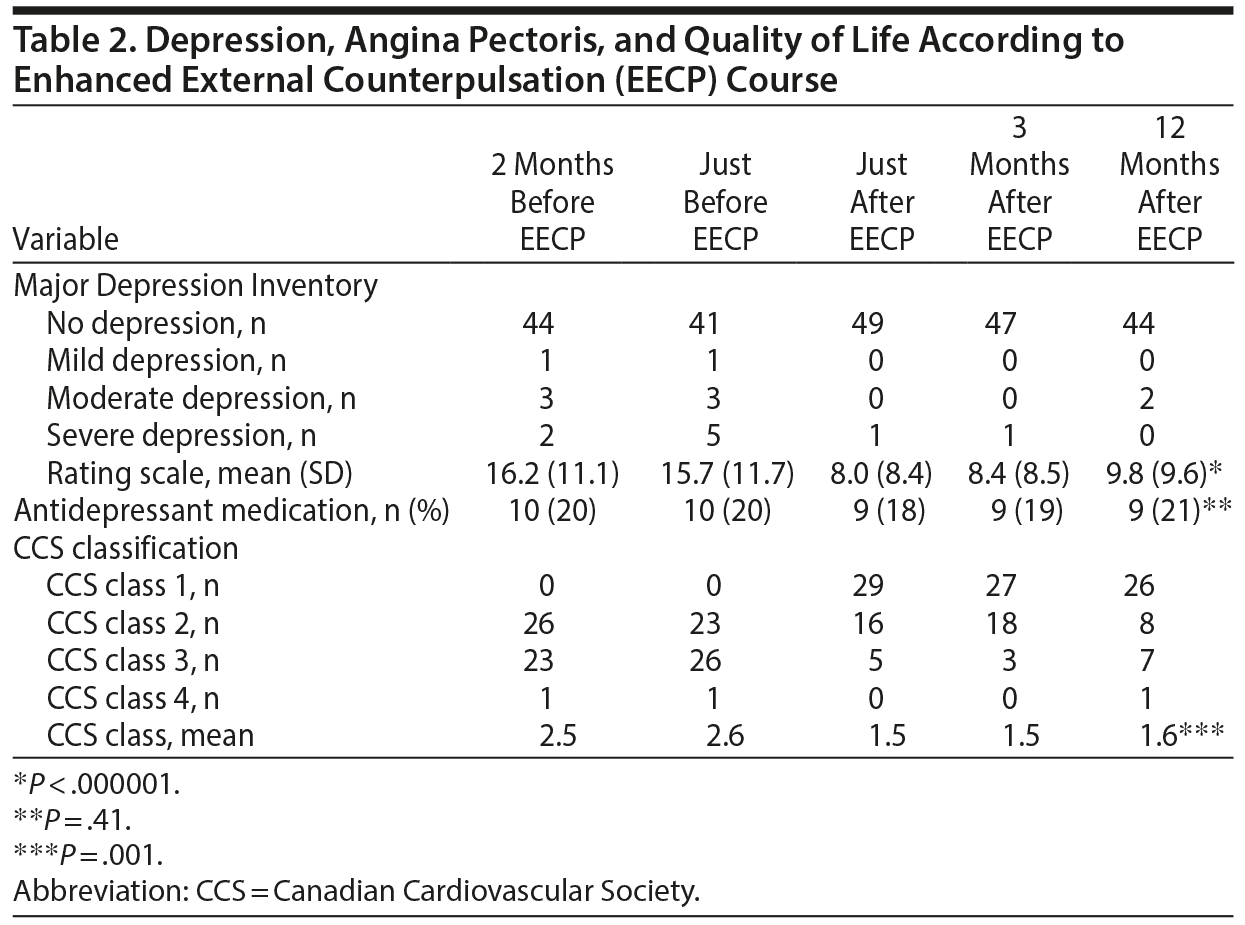
Effect of EECP on Depression
Just before EECP, 9 patients had depression (18%; mild: 2%, moderate: 6%, and severe: 10%); just after EECP, 1 patient had depression (severe: 2%); 3 months after EECP, 1 patient had depression (severe: 2%); and 12 months after EECP, 2 patients had depression (moderate: 4%) (P = .013) (Table 2, Figure 1). The change in depression during the 5 examinations using the MDI rating scale was highly significant (P < .000001). No change in the scale was found during the control period (P = .56), but in the follow-up period, a gradual increase in the MDI rating scale score was detected (P = .006) (Table 2). Compared to just before EECP, a significant decrease in the scale was found just after (7.7 points, P = .000002), 3 months after (6.9 points, P = .000004), and 12 months after (5.0 points, P = .0003) EECP. The effect on the MDI rating scale detected just after EECP compared to before EECP was in the group with depression (17.0 points, P = .002, n = 9) and in the group without depression (5.6 points, P = .00002, n = 41).
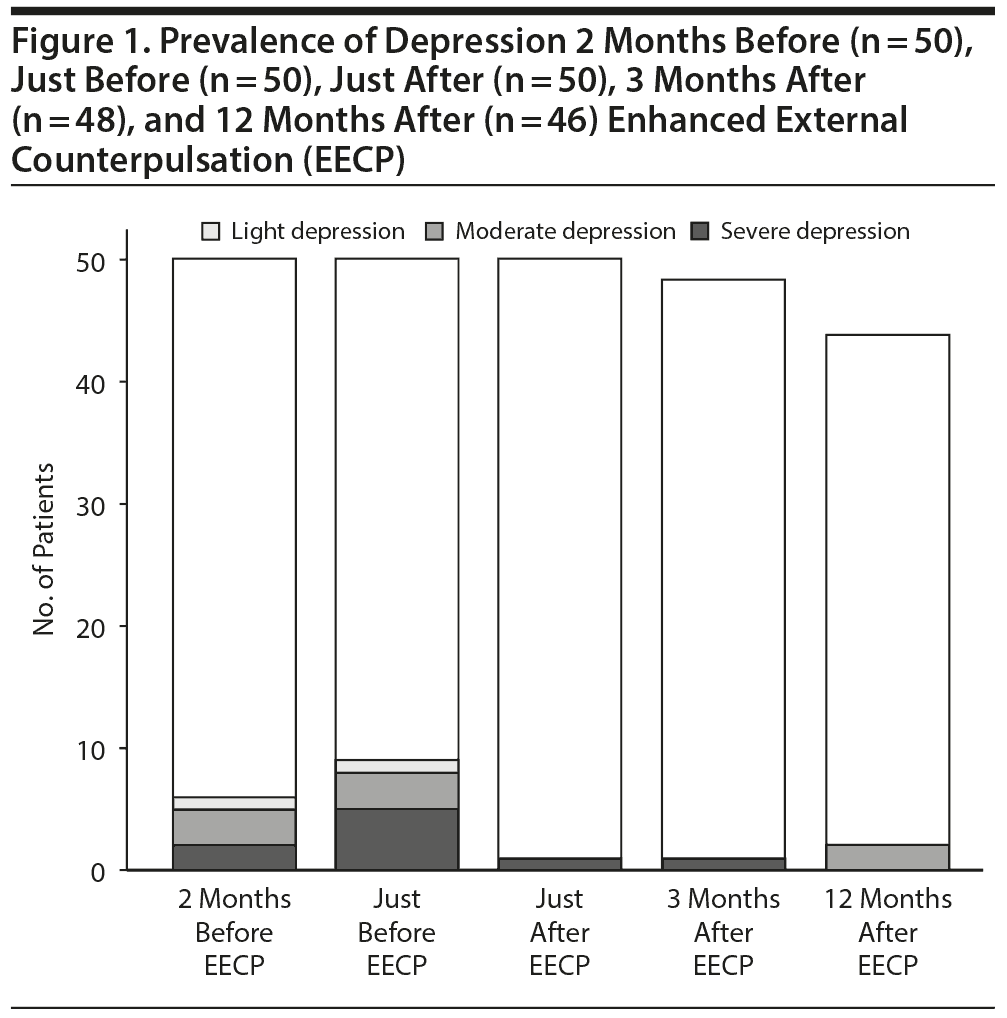
In Table 3, the response to each item of the MDI is shown. A highly significant change is observed in all 3 core symptoms (items 1–3), as well as in most of the other symptoms. Only items 10a and 10b concerning reduced or increased appetite were not significantly changed during the study.
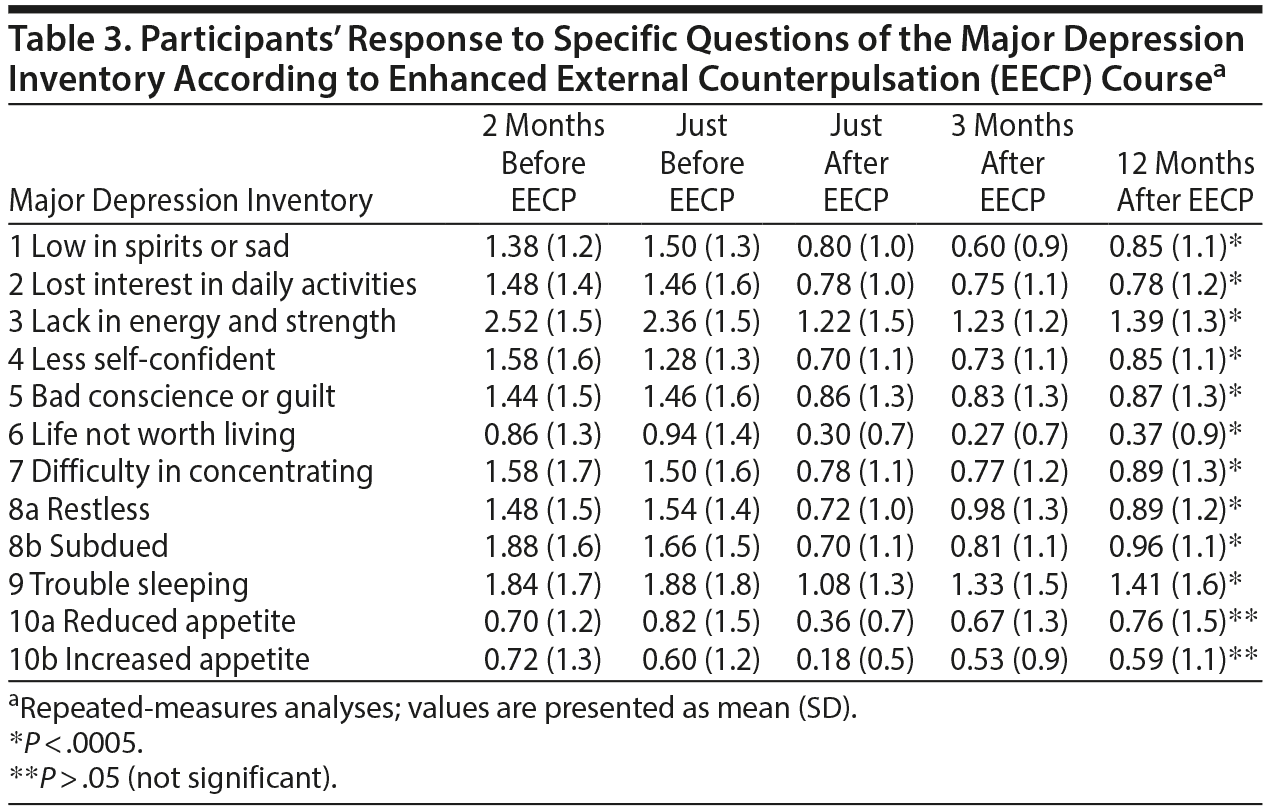
Predictors of Depression in
Refractory Angina Pectoris
The association between the baseline parameters routinely available in the clinic was tested against the MDI rating scale (Table 4). In the univariate analysis, a significant negative correlation was detected between age and the MDI rating scale (P = .016), indicating a more depressed state at a lower age. A highly significant association was found between treatment with antidepressant agents and depression (P = .003). A nonsignificant higher MDI rating scale score was found in patients with more severe angina CCS class 3–4 compared to CCS class 2 (P = .06), as well as in patients treated with nicorandil compared to those not treated with the medication (P = .06).
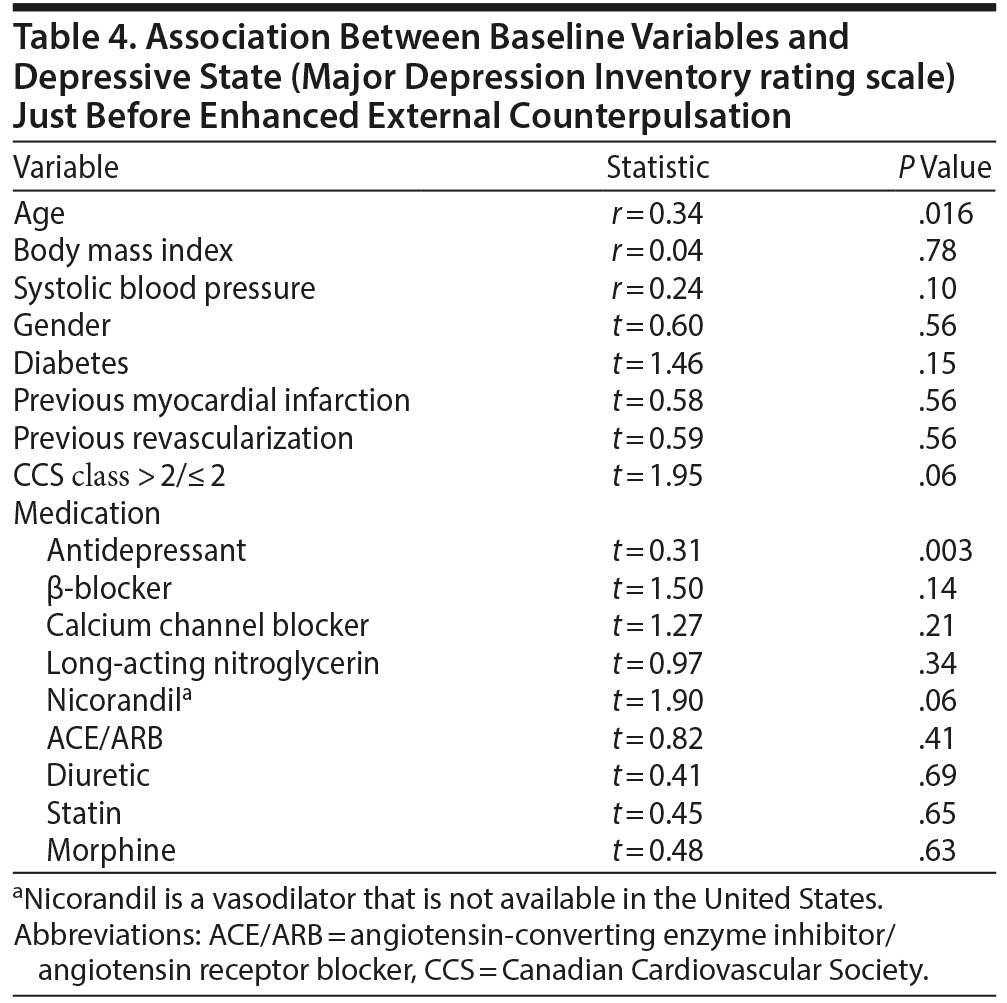
Variables with a P value < .10 were included in a multivariate regression analysis using the backward elimination principle. The analysis showed an independent correlation between a high MDI rating scale score and low age (P = .006), CCS class ≥ 3 (P = .002), treatment with an antidepressant agent (P = .0004), and treatment with nicorandil* (P = .003).
Predictors of Effect of EECP on Depression
The change in the MDI rating scale was tested against baseline variables (Table 5). In the univariate analysis, an improvement in the MDI rating scale was found to be highly significantly related to treatment with an antidepressant (P < .0005), and a nonsignificant relation was found to body mass index (P = .066).
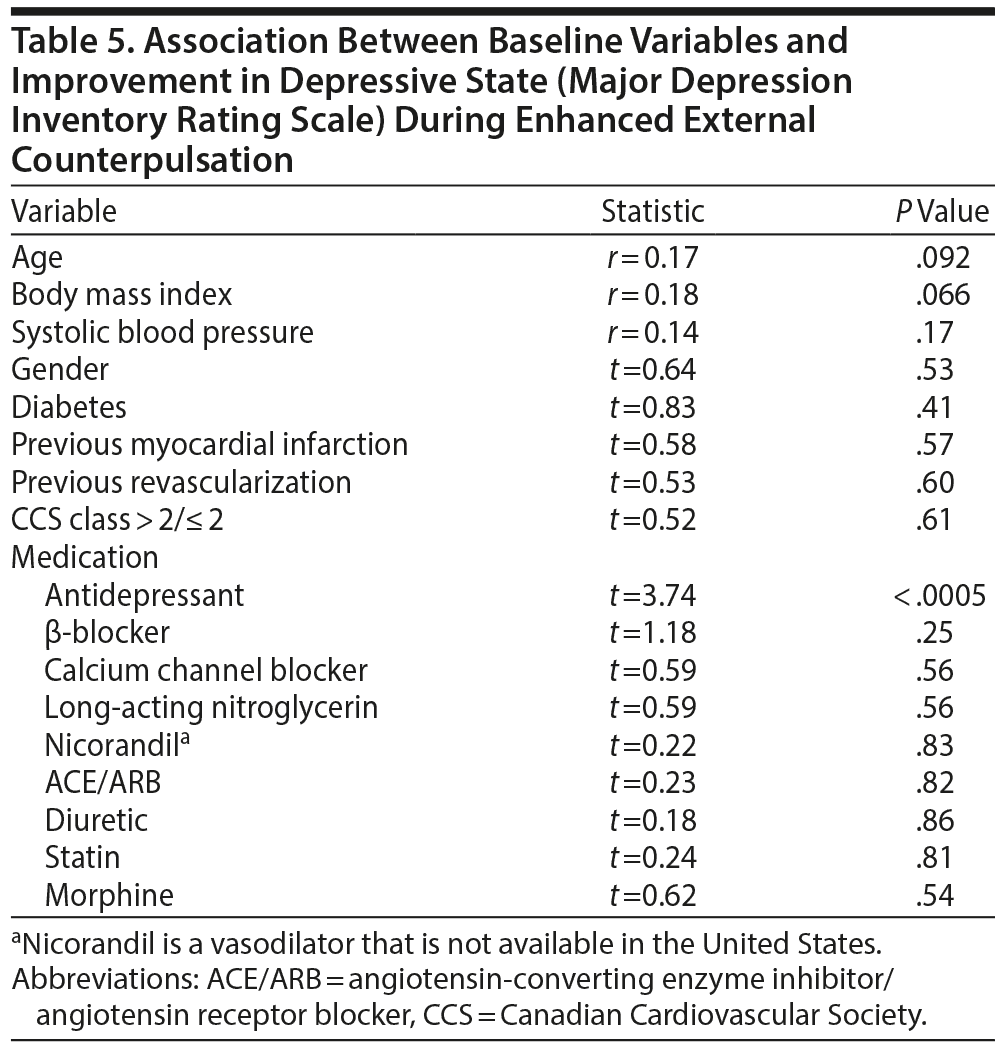
In the multivariate analysis including variables with a P value < .10 in the univariate analysis, an independently significant positive association was found only for treatment with antidepressant medication (P = .0005). In patients treated with an antidepressant, the MDI rating scale improved 17 points (from 25.1 to 8.1, P = .001, n = 10), and in the group that took no antidepressant medication, the rating scale improved 5.5 points (from 13.3 to 7.8, P = .0002, n = 40).
Association Between Effect of EECP
on Depression and Effect on Chest Pain
Angina pectoris was improved at least 1 CCS class in 82% of the participants. The change in the MDI rating scale in patients who improved at least 1 CCS class (16.2 to 8.2 points) did not differ significantly compared to the change in patients who did not improve in CCS class (13.0 to 7.2 points) (P = .54). Similarly, the change in the MDI rating scale was not associated with the mean fall in number of nitroglycerin uses from the first week of the EECP course to the last week (r = 0.12, P = .39).
DISCUSSION
The prevalence of depression just before EECP was 18%. This finding is comparable with the result reported by Borowicz et al,23 who found a prevalence of 16% in patients with stable ischemic heart disease. During the control period in the 2 months before EECP, no significant change was detected in the MDI rating scale, indicating that the improvement in depression during EECP was unlikely to be caused by an influence of the regression-toward-the-mean phenomenon. Additionally, the improvement in the MDI rating scale could not be caused by the introduction of antidepressant medication, as none of the participants started antidepressants during the study period, and 1 patient stopped antidepressant medication just after EECP. The significant elevation in mood was seen in all the items of the MDI except for change in appetite. Further, EECP was also followed by a significant elevation in mood among patients who were not taking antidepressant medication.
The intensity of chest pain reported by the participants was reduced significantly. We found that 82% of the patients were classified at least 1 CCS class lower after EECP compared to before. This result is comparable to other reports.24–26
Just after EECP, only 1 patient had depression. After 3 months, 1 patient had depression, and after 12 months, 2 patients had depression. EECP, therefore, seems to be an effective treatment for depression in patients with refractory angina pectoris. This finding is in agreement with the study by Springer et al,20 who found that depression assessed on 2 scales, the Beck Depression Inventory and the Symptom Checklist-90-Revised, was significantly reduced after an EECP course. The effect of EECP on depression using a diagnostic approach such as the MDI has to our knowledge not been assessed before.
The depressive state was most pronounced in younger patients, in patients taking antidepressants, and in patients treated with nicorandil. A higher prevalence of depression in younger patients with ischemic heart disease was also reported in a study carried out in patients with acute coronary syndrome.27 The reason for this finding is not known, but it seems obvious that serious heart disease may be more threatening and thus more likely to induce depression when you are younger, are still working, and have a family to support.
The group of patients taking antidepressant medication had a higher score on the MDI rating scale compared to the group not taking antidepressants. This finding is not surprising and reflects the fact that antidepressants are given to patients with depression.
The MDI rating scale score was higher in the 19 patients treated with nicorandil. This drug is not a first-line treatment for angina pectoris, so the use of the drug is probably a marker of more severe symptoms. The association between depression and use of nicorandil may thus be due to more severe symptoms in this subgroup compared to the patients not treated with nicorandil. Depression is not a known adverse effect of the drug.
The only factor known at baseline that could predict an effect of EECP on depression was treatment with an antidepressant drug. Treatment with an antidepressant was associated with a high score on the MDI rating scale. It is therefore not surprising that this patient group had the greatest effect of EECP.
We found no association between a decline in depressive state as expressed by the MDI rating scale and reduced chest pain. The study thus does not indicate that the decline in depressive mood after EECP is due to reduced chest pain.
The pathophysiology behind the positive effect of EECP on depression is not known, but different pathways could be involved. In patients with depression, a reduced endothelial function has been found,28,29 and it has been demonstrated that endothelial dysfunction is associated with atherosclerosis in the early stage.30 EECP has been shown to improve the endothelial function, both biochemically and clinically. A decline in the potent vasoconstrictor endothelin-131 and a rise in nitric oxide32 were reported in smaller studies. Clinically, an improvement in the endothelial function was demonstrated by flow-mediated vasodilatation in the brachial artery33 as well as reactive hyperemia peripheral arterial tonometry.34 It therefore seems possible that the stress produced by EECP improves the reduced endothelial function seen in depression and that this may be a part of the pathophysiologic mechanisms explaining the effect of EECP on depression in patients with ischemic heart disease and refractory angina pectoris.
Furthermore, depression is known to be correlated with an increase in a wide range of inflammatory parameters,35 and ischemic heart disease inflammation is known to play a role in the development of coronary plaque.36 An increase in inflammatory parameters, as for example high sensitive C-reactive protein measured in the peripheral blood, is a marker of high risk in patients with coronary artery disease.37 These inflammatory parameters have been found to decline during EECP treatment.38 Reduction in inflammatory parameters by EECP may thus also be a part of the yet unknown mechanism explaining the effect of EECP on depression. Finally, it cannot be excluded that the daily contact with a nurse 5 times a week for 7 weeks may have had an unspecific positive effect on depression.
Limitations of the Study
Although the effect of EECP on depression was significant, the number of patients was small, and the study was not randomized. Larger randomized controlled studies are needed to confirm the findings of this study.
CONCLUSION
This study indicates that EECP is an effective treatment for depression in patients with refractory angina pectoris and that the effect is still present 12 months after EECP. The effect of EECP on depression does not seem to be related to the effect on chest pain, and the effect is unlikely to be caused by regression-toward-the-mean.
Author affiliations: Cardiovascular Research Unit, Department of Medicine, Regional Hospital West Jutland (Dr May); and Psychiatric Research Unit West, Regional Psychiatric Services West (Dr Søgaard), Herning, Denmark.
Potential conflicts of interest: None reported.
Funding/support: The study was funded by the Danish Heart Foundation (06-10-B551-A1204-22346) and the County of Ringkøbing.
Role of the sponsor: The sponsor had no influence on the design or conduct of the study; collection, management, analysis, or interpretation of the data; or preparation, review, or approval of the manuscript.
REFERENCES
1. Barefoot JC, Helms MJ, Mark DB, et al. Depression and long-term mortality risk in patients with coronary artery disease. Am J Cardiol. 1996;78(6):613–617. doi:10.1016/S0002-9149(96)00380-3 PubMed
2. Levinson D, Karger CJ, Haklai Z. Chronic physical conditions and use of health services among persons with mental disorders: results from the Israel National Health Survey. Gen Hosp Psychiatry. 2008;30(3):226–232. doi:10.1016/j.genhosppsych.2008.02.007 PubMed
3. Fenton WS, Stover ES. Mood disorders: cardiovascular and diabetes comorbidity. Curr Opin Psychiatry. 2006;19(4):421–427. doi:10.1097/01.yco.0000228765.33356.9f PubMed
4. Cassano P, Fava M. Depression and public health: an overview. J Psychosom Res. 2002;53(4):849–857. doi:10.1016/S0022-3999(02)00304-5 PubMed
5. Spijkerman T, de Jonge P, van den Brink RH, et al. Depression following myocardial infarction: first-ever versus ongoing and recurrent episodes. Gen Hosp Psychiatry. 2005;27(6):411–417. doi:10.1016/j.genhosppsych.2005.05.007 PubMed
6. Van der Kooy K, van Hout H, Marwijk H, et al. Depression and the risk for cardiovascular diseases: systematic review and meta-analysis. Int J Geriatr Psychiatry. 2007;22(7):613–626. doi:10.1002/gps.1723 PubMed
7. Valkanova V, Ebmeier KP. Vascular risk factors and depression in later life: a systematic review and meta-analysis. Biol Psychiatry. 2013;73(5):406–413. PubMed
8. Rutledge T, Reis VA, Linke SE, et al. Depression in heart failure a meta-analytic review of prevalence, intervention effects, and associations with clinical outcomes. J Am Coll Cardiol. 2006;48(8):1527–1537. doi:10.1016/j.jacc.2006.06.055 PubMed
9. van Melle JP, de Jonge P, Spijkerman TA, et al. Prognostic association of depression following myocardial infarction with mortality and cardiovascular events: a meta-analysis. Psychosom Med. 2004;66(6):814–822. doi:10.1097/01.psy.0000146294.82810.9c PubMed
10. Spijkerman TA, van den Brink RH, May JF, et al. Decreased impact of postmyocardial infarction depression on cardiac prognosis? J Psychosom Res. 2006;61(4):493–499. doi:10.1016/j.jpsychores.2006.02.016 PubMed
11. Barth J, Schumacher M, Herrmann-Lingen C. Depression as a risk factor for mortality in patients with coronary heart disease: a meta-analysis. Psychosom Med. 2004;66(6):802–813. doi:10.1097/01.psy.0000146332.53619.b2 PubMed
12. Wulsin LR, Singal BM. Do depressive symptoms increase the risk for the onset of coronary disease? a systematic quantitative review. Psychosom Med. 2003;65(2):201–210. doi:10.1097/01.PSY.0000058371.50240.E3 PubMed
13. Rugulies R. Depression as a predictor for coronary heart disease: a review and meta-analysis. Am J Prev Med. 2002;23(1):51–61. doi:10.1016/S0749-3797(02)00439-7 PubMed
14. Pan A, Sun Q, Okereke OI, et al. Depression and risk of stroke morbidity and mortality: a meta-analysis and systematic review. JAMA. 2011;306(11):1241–1249. doi:10.1001/jama.2011.1282 PubMed
15. Dong JY, Zhang YH, Tong J, et al. Depression and risk of stroke: a meta-analysis of prospective studies. Stroke. 2012;43(1):32–37. doi:10.1161/STROKEAHA.111.630871 PubMed
16. Huang CQ, Dong BR, Lu ZC, et al. Chronic diseases and risk for depression in old age: a meta-analysis of published literature. Ageing Res Rev. 2010;9(2):131–141. doi:10.1016/j.arr.2009.05.005 PubMed
17. Taylor D, Meader N, Bird V, et al; Pharmacology Subgroup of the National Institute for Health and Clinical Excellence Guideline Development Group for Depression in Chronic Physical Health Problems. Pharmacological interventions for people with depression and chronic physical health problems: systematic review and meta-analyses of safety and efficacy. Br J Psychiatry. 2011;198(3):179–188. doi:10.1192/bjp.bp.110.077610 PubMed
18. Lawson WE, Kennard ED, Hui JCK, et al; IEPR Investigators. Analysis of baseline factors associated with reduction in chest pain in patients with angina pectoris treated by enhanced external counterpulsation. Am J Cardiol. 2003;92(4):439–443. doi:10.1016/S0002-9149(03)00662-3 PubMed
19. Michaels AD, Accad M, Ports TA, et al. Left ventricular systolic unloading and augmentation of intracoronary pressure and Doppler flow during enhanced external counterpulsation. Circulation. 2002;106(10):1237–1242. doi:10.1161/01.CIR.0000028336.95629.B0 PubMed
20. Springer S, Fife A, Lawson W, et al. Psychosocial effects of enhanced external counterpulsation in the angina patient: a second study. Psychosomatics. 2001;42(2):124–132. doi:10.1176/appi.psy.42.2.124 PubMed
21. Bech P, Rasmussen N-A, Olsen LR, et al. The sensitivity and specificity of the Major Depression Inventory, using the Present State Examination as the index of diagnostic validity. J Affect Disord. 2001;66(2–3):159–164. doi:10.1016/S0165-0327(00)00309-8 PubMed
22. World Health Organization. International Statistical Classification of Diseases and Related Health Problems. 10th Revision. Geneva, Switzerland: World Health Organization; 2006.
23. Borowicz L Jr, Royall R, Grega M, et al. Depression and cardiac morbidity 5 years after coronary artery bypass surgery. Psychosomatics. 2002;43(6):464–471. doi:10.1176/appi.psy.43.6.464 PubMed
24. Stys TP, Lawson WE, Hui JCK, et al. Effects of enhanced external counterpulsation on stress radionuclide coronary perfusion and exercise capacity in chronic stable angina pectoris. Am J Cardiol. 2002;89(7):822–824. doi:10.1016/S0002-9149(02)02191-4 PubMed
25. Gloth S, Oken HA. Enhanced external counterpulsation: the Howard County experience in the first 18 patients. Md Med J. 1999;48(4):155–156. PubMed
26. Tartaglia J, Stenerson J Jr, Charney R, et al. Exercise capability and myocardial perfusion in chronic angina patients treated with enhanced external counterpulsation. Clin Cardiol. 2003;26(6):287–290. doi:10.1002/clc.4950260610 PubMed
27. Dessotte CA, Silva FS, Bolela F, et al. Presence of depressive symptoms in patients with a first episode of acute coronary syndrome. Rev Lat Am Enfermagem. 2013;21(1):325–331. doi:10.1590/S0104-11692013000100006 PubMed
28. Sherwood A, Hinderliter AL, Watkins LL, et al. Impaired endothelial function in coronary heart disease patients with depressive symptomatology. J Am Coll Cardiol. 2005;46(4):656–659. doi:10.1016/j.jacc.2005.05.041 PubMed
29. Tomfohr LM, Martin TM, Miller GE. Symptoms of depression and impaired endothelial function in healthy adolescent women. J Behav Med. 2008;31(2):137–143. doi:10.1007/s10865-007-9141-4 PubMed
30. Elovainio M, Keltikangas-Järvinen L, Kivimäki M, et al. Depressive symptoms and carotid artery intima-media thickness in young adults: the Cardiovascular Risk in Young Finns Study. Psychosom Med. 2005;67(4):561–567. doi:10.1097/01.psy.0000170340.74035.23 PubMed
31. Garlichs CD, Zhang H, Werner D, et al. Reduction of serum endothelin-1 levels by pneumatic external counterpulsation. Can J Cardiol. 1998;14(suppl F):87F.
32. Masuda D, Nohara R, Hirai T, et al. Enhanced external counterpulsation improved myocardial perfusion and coronary flow reserve in patients with chronic stable angina: evaluation by(13)N-ammonia positron emission tomography. Eur Heart J. 2001;22(16):1451–1458. doi:10.1053/euhj.2000.2545 PubMed
33. Shechter M, Matetzky S, Feinberg MS, et al. External counterpulsation therapy improves endothelial function in patients with refractory angina pectoris. J Am Coll Cardiol. 2003;42(12):2090–2095. doi:10.1016/j.jacc.2003.05.013 PubMed
34. Bonetti PO, Barsness GW, Keelan PC, et al. Enhanced external counterpulsation improves endothelial function in patients with symptomatic coronary artery disease. J Am Coll Cardiol. 2003;41(10):1761–1768. doi:10.1016/S0735-1097(03)00329-2 PubMed
35. Kop WJ, Gottdiener JS. The role of immune system parameters in the relationship between depression and coronary artery disease. Psychosom Med. 2005;67(suppl 1):S37–S41. doi:10.1097/01.psy.0000162256.18710.4a PubMed
36. Shimbo D, Davidson KW, Haas DC, et al. Negative impact of depression on outcomes in patients with coronary artery disease: mechanisms, treatment considerations, and future directions. J Thromb Haemost. 2005;3(5):897–908. doi:10.1111/j.1538-7836.2004.01084.x PubMed
37. Pearson TA, Mensah GA, Alexander RW, et al; American Heart Association. Markers of inflammation and cardiovascular disease: application to clinical and public health practice: a statement for health care professionals from the Centers for Disease Control and Prevention and the American Heart Association. Circulation. 2003;107(3):499–511. doi:10.1161/01.CIR.0000052939.59093.45 PubMed
38. Casey DP, Conti CR, Nichols WW, et al. Effect of enhanced external counterpulsation on inflammatory cytokines and adhesion molecules in patients with angina pectoris and angiographic coronary artery disease. Am J Cardiol. 2008;101(3):300–302. doi:10.1016/j.amjcard.2007.08.031 PubMed
*Nicorandil is a vasodilator that is not available in the United States.
Please sign in or purchase this PDF for $40.00.

